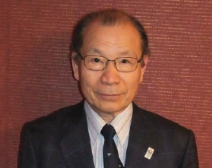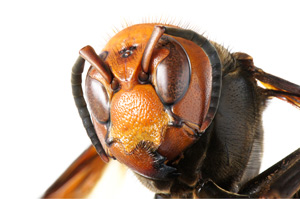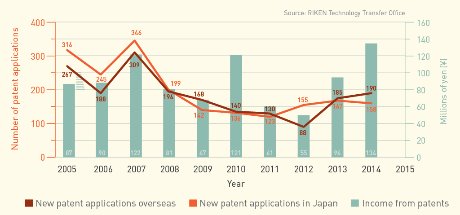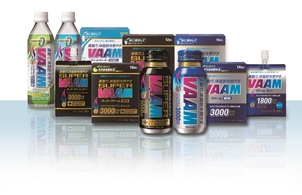Nov. 13, 2015 Impact Biology
The power of hornet juice
RIKEN researchers turned an amino acid mixture produced by giant hornets into a commercially successful sports drink that improves athletic endurance and fat metabolism

Spit and stamina
 Hornets travel long distances in search of insects to feed their larvae. @contrail1/ iStock/ Thinkstock
Hornets travel long distances in search of insects to feed their larvae. @contrail1/ iStock/ Thinkstock
The day after recovering from the sting, Abe decided to continue his research on the hornets (Vespa mandarinia ) by studying their behavior more closely. Their feeding habits were particularly intriguing. Adult hornets fly almost 100 kilometers a day in pursuit of insects to feed their developing young. They grind fresh prey into tiny meatballs and exchange it with their larvae for saliva, which is the only source of food for the adult workers, whose narrow waist and short gut restricts their diet to liquids.
Abe wondered what was in the translucent spit that gave the adult hornets the energy to travel such distances. He tested saliva samples secreted by nesting larvae and found they contained 17 different amino acids. “It was a special composition, very different from the amino acids consumed as proteins in milk, meat or fish,” he explains. He named the amino acid concoction ‘Vespa amino acid mixture’, or ‘VAAM’ for short, and filed the first of many patents in Japan and abroad.
Abe found that VAAM helped mice swim in a turbulent pool. Mice fed VAAM swam for significantly longer than those fed either water, glucose or a different amino acid mixture. The same mice also had less lactate and more glucose in their bloodstreams, a finding that established the role of glucose homeostasis in endurance exercise.
The low lactate levels suggested that VAAM sped up fatty acid metabolism, one of two sources of the energy required for muscle activity. Abe repeated the swimming mouse experiment, this time testing for free fatty acids in the bloodstream and found that VAAM also accelerated fat oxidation. Over the years, he would conduct many more studies to characterize the exact metabolic effect of VAAM and its efficacy for reducing fatigue. “Amino acids are typically thought of as nutrients,” he says, “but VAAM pointed to a different role for amino acids as transmitters of information to the body.”
VAAM in a can
 While the number of patents filed by RIKEN has leveled over the last decade, the amount of income earned from patents is on the rise. © 2015 RIKEN
While the number of patents filed by RIKEN has leveled over the last decade, the amount of income earned from patents is on the rise. © 2015 RIKEN
By the early 1990s, many major companies showed interest in commercializing VAAM as a sports drink for athletes. But problems with flavor and financial feasibility persisted. “Amino acids have a very bitter taste, like raw fish,” explains Abe. Furthermore, except for a select few amino acids like glycine, glutamic acid and lysine produced in industrial quantities and used in animal feed and food additives, many VAAM components were not available in large quantities.
A felicitous partnership with the food company Meiji Dairies and biotech giant Kyowa Hakko eventually resolved these problems. Kyowa developed efficient techniques for fermenting many more amino acids en masse and extracting others from bird feathers. Larval saliva contains a lot of trehalose, a natural sugar, so Abe decided to introduce the same sweetener to VAAM, which significantly improved its taste. More good news came when a Japanese company succeeded in cheaply manufacturing trehalose from starch.
The first product named VAAM (without the italicized ‘V’) was launched in Japan in September 1995. It contained 3 grams of the amino acid mixture diluted in a small silver can with a bold-colored logo. The brand became so successful that Meiji Dairies released a whole range of sister products, from VAAM Powder to VAAM Jelly Diet Special and Super VAAM. VAAM was everywhere—in drugstores, health food shops and convenience stores. Even Olympic athletes were drinking VAAM, culminating in the long-distance runner Naoko Takahashi’s gold-medal win at the 2000 Sydney Olympics.
Success story
 VAAM products © 2015 Meiji Co., Ltd.
VAAM products © 2015 Meiji Co., Ltd.
VAAM is one of several commercially successful products that have originated from RIKEN, including the detergent Attack that contains an enzyme discovered at the institution, says Ryosuke Furubayashi, deputy director of the Collaborations Division and head of the Technology Transfer Office that secures patent rights from RIKEN’s research activities and transfers them to industry, as well as providing support and information for researchers about the demands of industry.
“Compared to ten years ago, RIKEN today is more focused on investing resources in inventions that are attractive to industry,” he says. This means that while the number of patents filed has plateaued over the years, the amount of money RIKEN earns from these patents is increasing. Collaborations with industry have also matured to include the establishment of long-term joint research centers or laboratories customized to the needs of a specific company.
More than 30 years since his near-death experience, Abe is still trying to understand the unique properties of VAAM. Most recently, he has characterized its effect on gene expression. An intervention study on sedentary women above the age of 60 by researchers at the University of Tsukuba in 2008 suggests that VAAM could also benefit non-athletes and the elderly. Abe offers himself as an example of one of VAAM’s most loyal consumers: “You should drink it too,” he says.
